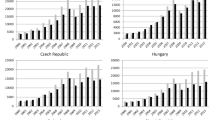Abstract
Identifying the most important systemic characteristics that have determined the behavior of CPEs is crucial for the choice of a transition path within the ongoing economic reforms in these countries. The empirical literature on the comparative behavior of CPEs and MEs often gives little help in explaining exactly why the economic performance of CPEs differs from that of MEs. This is certainly the case for studies that have previously examined the comparative levels of CPE trade. Employing the data and methodology of an existing study (Browning, 1985), and adding a variable representing the level of MNC activity in each country, it is shown that the low levels of CPE trade can be completely explained by the NMC activity, without recourse to other effects of the economic system.
Similar content being viewed by others
Abbreviations
- CPE:
-
Centrally Planned Economy
- ME:
-
Market Economy
- MNC:
-
Multinational Corporation
- CMEA:
-
Council for Mutual Economic Assistance
References
Browning, M. (1985), ‘The trend level of imports by CMEA countries’, Journal of Comparative Economics 9(4), 363–370.
Coase, R.H. (1937), ‘The nature of the firm’, Economica 4, 386–405.
Dunning, J. (1981), International Production and the Multinational Enterprise, Allen & Unwin, London, Boston.
Dunning, J. and Cantwell, J. (1987), IRM Directory of Statistics of International Investment and Production, Macmillan, Basingstoke.
Ethier, W.J. (1986), ‘The multinational firm’, Quarterly Journal of Economics 101(4), 805–833.
Helpman, E. and Krugman, P.R. (1985), Market Structure and Foreign Trade: Increasing Returns, Imperfect Competition, and the International Economy, The MIT Press, Cambridge, MA.
Hewett, E.A. (1980), ‘Foreign trade outcomes in Eastern and Western economies’, in P. Marer and J.M. Montias (eds.), East European Integration and East-West Trade, Indiana University Press, Bloomington.
Holzman, F. (1968), ‘Foreign trade behavior of centrally-planned economies’, in H. Rosovsky (ed.), Industrialization in Two Systems; Essays in Honor of Alexander Gerschenkeron, John Wiley, New York.
MacMillan, C. (1977), ‘East-West industrial cooperation’, in East European Economies Post-Helsinki, U.S. Government Printing Office, pp. 1175–1224, Washington, D.C.
Markusen, J.R. (1984), ‘Factor movements and commodity trade as complements’, Journal of International Economics 43, 341–356.
Markusen, J.R. (1984), ‘Multinationals, multi-plant economies, and the gains from trade’, Journal of International Economics 16, 205–226.
Van Brabant, J. (1986), Bilateralism and Structural Bilateralism in Intra-CMEA Trade, Rotterdam University Press, Rotterdam.
Williamson, O.E. (1975), Markets and Hierarchies, Analysis and Antitrust Implications: A Study in the Economies of Internal Organization, Free Press, New York.
Author information
Authors and Affiliations
Rights and permissions
About this article
Cite this article
Murrell, P. The effect of (the absence of) multinationals' foreign direct investment on the level of Eastern European trade. Economics of Planning 24, 151–160 (1991). https://doi.org/10.1007/BF00347667
Issue Date:
DOI: https://doi.org/10.1007/BF00347667




